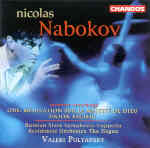Here’s how you make an “American” ballet: First, choose a super-American topic (such as the building of the Union Pacific railway); second, use quirky, off-kilter dance rhythms; and third, liberally quote–in a majestic and cloyingly dissonant fashion–some popular folk songs such as “Yankee Doodle” or “Oh Susannah”. Composer Nicolas Nabokov, cousin of the famous novelist, seems to have followed such a recipe in contriving his ballet score Union Pacific, an impressive yet ultimately formulaic piece of work. Similar compositional schemes and themes were “in the air” in the 1930s, but other composers (Copland, Thomson, and Carter, for instance) were doing it better. Despite Valeri Polyansky’s precise and focused reading, Union Pacific just sounds like off-the-shelf ingredients stuffed into a cheap, generic box. No amount of lively two-steps or brilliant orchestrational moments can take your mind off the fact that this is Americana Redux, Copland lite.
Despite the pompous title, Nabokov’s ballet-oratorio Ode: Méditation sur la majesté de Dieu is more successful because the composer stays closer to the musical style he knows best. Not to say that a native Russian composer cannot write excellent “American” music–Stravinsky certainly did–but Nabokov does not have the versatility of his brilliant countryman, nor the thoroughly original and personal sound. He is much more at home with the Ode’s Mussorgsky-like grand gestures coupled with the orchestrational sense of a composer such as Rimsky-Korsakov.
Nevertheless, the piece is much too long. The liner notes hail the lack of polyphony as one of the work’s conscious compositional choices (and therefore a stength?), but the big sweeping chords wear after a while. Nabokov’s use of the chorus is not only very effective and idiomatic, but very Russian–though (to invoke Stravinsky again) the writing pales next to a work such as Les Noces. In fact, while both of the featured pieces show themselves as the fully formed offerings of a technically apt composer, they lack the originality and sparkle of Nabokov’s more illustrious contemporaries (Stravinsky, Gershwin, et al.).
For their part, Polyansky and his Residentie Orchestra and Russian State Symphonic Cappella do their best to impress us with this often undistinguished music. However, “undistinguished” doesn’t necessarily mean “not worth hearing”–and it’s good that Chandos is willing to take the risk and issue lesser-known repertoire, especially with top-notch and well-recorded performances such as these. It serves not only to give the music a proper day in court, but provides useful historical documents for reference and comparison.
































